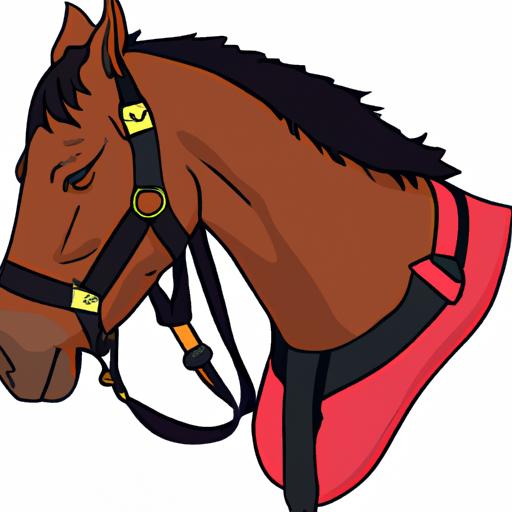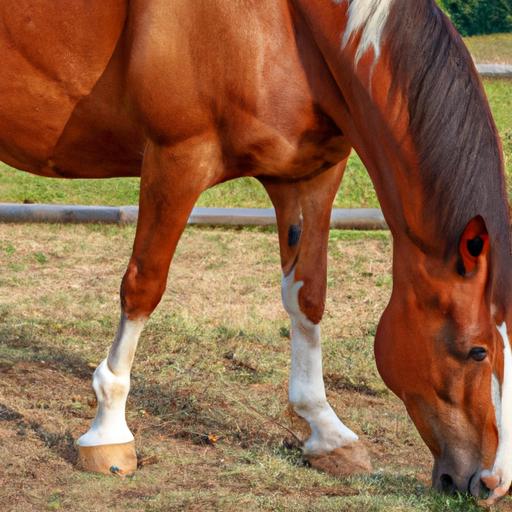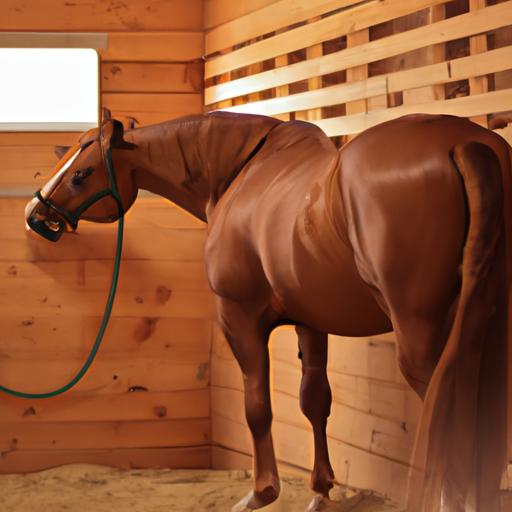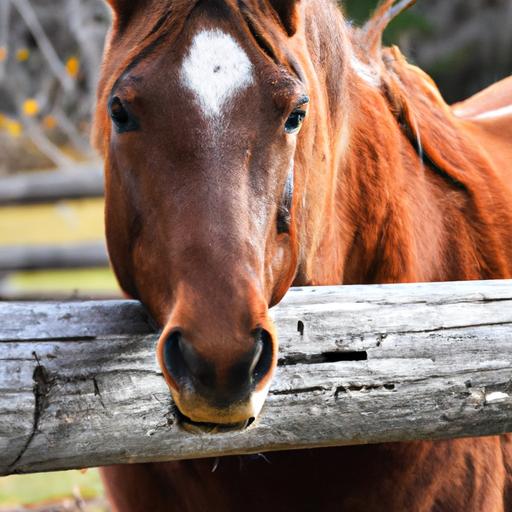Unraveling the mystery: is horse cribbing a learned behavior? Gain insights into this equine phenomenon and discover effective management strategies.
Horse cribbing, a peculiar behavior observed in some equines, has intrigued horse enthusiasts and experts alike. But what exactly is horse cribbing, and is it a learned behavior? In this article, we will delve into the depths of cribbing, exploring its definition, significance, and shedding light on the nature of this enigmatic phenomenon.
Introduction: Defining and Understanding Horse Cribbing

Horse cribbing refers to the act of a horse grasping an object, such as a fence or a stall door, with its incisors and then pulling back while emitting a characteristic grunting noise. This behavior may seem harmless at first glance, but it can have detrimental effects on the horse’s health and well-being.
Understanding the intricacies of cribbing is crucial for horse owners, trainers, and caretakers. By gaining insight into this behavior, we can better comprehend its underlying causes and develop effective strategies to manage and prevent it. But before we delve deeper, let’s acknowledge why comprehending horse cribbing is of utmost importance.
The Significance of Understanding Horse Cribbing

As horse enthusiasts, we strive to provide the best care for our equine companions. By unraveling the mystery behind cribbing, we can ensure their physical and mental well-being. Knowledge about cribbing aids in identifying potential underlying issues, ranging from dietary imbalances to inadequate socialization. Moreover, understanding cribbing can help us distinguish it from other stereotypic behaviors, allowing for targeted interventions.
The next sections will explore the nature of cribbing, analyzing whether it is a learned behavior or influenced by other factors. Join me on this journey as we uncover the truth behind horse cribbing and equip ourselves with the necessary knowledge to provide the best care for our beloved horses.
Is Horse Cribbing a Learned Behavior?

Debunking Misconceptions and Common Myths
Before we delve into whether horse cribbing is a learned behavior, let’s address some prevailing misconceptions surrounding this peculiar habit. One common myth is that cribbing is solely a result of boredom or bad habits. However, research suggests that there is more to cribbing than meets the eye. It is essential to dispel these misconceptions to gain a more accurate understanding of the behavior.
Scientific Studies and Research on Cribbing Behavior
Scientific studies have played a pivotal role in unraveling the mysteries of horse cribbing. Researchers have conducted numerous experiments and observations to shed light on its origin and nature. These studies have provided valuable insights into the complex nature of cribbing, helping us understand its underlying causes and potential triggers.
Role of Genetics and Environment in Cribbing
The question of whether cribbing is a learned behavior or influenced by genetic factors has long intrigued experts. While some argue that genetics play a significant role in predisposing horses to cribbing, others believe that environmental factors are primarily responsible. To gain a comprehensive understanding, we need to explore the interplay between genetics and the horse’s environment and how it contributes to the development of cribbing behavior.
Comparison with Other Equine Stereotypic Behaviors
Examining cribbing in the context of other equine stereotypic behaviors can provide us with valuable insights. By comparing cribbing with behaviors such as weaving or stall walking, we can identify commonalities and differences. This comparative analysis helps us understand the unique aspects of cribbing and its potential underlying mechanisms.
Join me in the next sections as we delve deeper into the environmental factors influencing cribbing behavior and explore the distinction between learned behavior and coping mechanisms. Through a holistic understanding of horse cribbing, we can unlock the secrets behind this intriguing habit and enhance our approach to managing and preventing it.
Environmental Factors Influencing Cribbing Behavior
When it comes to horse cribbing, several environmental factors play a significant role. It’s crucial to assess and address these factors to effectively manage and prevent cribbing behaviors in our equine friends. Let’s explore the key environmental factors that can influence cribbing behavior:
1. Lack of Turnout and Exercise
Horses are naturally active animals that require regular exercise and ample time spent outdoors. When confined to a stall or limited turnout, they may experience frustration, leading to cribbing as a coping mechanism. Lack of physical activity and restricted movement can contribute to the development of cribbing behaviors in horses. Providing sufficient turnout and exercise opportunities can help alleviate this issue.
2. Feeding and Diet Factors
Dietary considerations are another crucial aspect to evaluate when addressing cribbing behavior. Horses with limited access to forage, improper feeding schedules, or nutrient imbalances may resort to cribbing as a means of alleviating stress or discomfort. Ensuring a balanced diet, with a proper forage-to-concentrate ratio, can reduce the likelihood of cribbing behaviors.
3. Social Interaction and Bonding
Horses are social animals that thrive on companionship and interaction with their herd mates. Isolation or limited socialization opportunities can lead to boredom and loneliness, triggering cribbing behaviors. Providing adequate social interaction, whether through turnout with compatible companions or structured activities, can mitigate the risk of cribbing.
4. Boredom and Monotony
Horses, like humans, can experience boredom and monotony when subjected to repetitive or unstimulating environments. Insufficient mental stimulation and environmental enrichment can drive horses to engage in cribbing behaviors. By introducing varied activities, toys, and environmental enrichment strategies, we can keep our equine friends engaged, reducing the likelihood of cribbing.
By addressing these environmental factors and implementing appropriate management strategies, we can create a conducive environment that minimizes the occurrence of cribbing behaviors. Stay tuned as we further explore the intricate relationship between learned behavior and cribbing in the upcoming sections.
Learned Behavior vs. Coping Mechanism
Understanding whether horse cribbing is a learned behavior or a coping mechanism is crucial in addressing this perplexing issue. Let’s explore the psychological and emotional factors that contribute to cribbing and how stress, reinforcement, and human interaction influence this behavior.
Psychological and Emotional Factors
Horses, like humans, experience a range of emotions and may exhibit behaviors as a response to their psychological state. Cribbing can be linked to feelings of frustration, boredom, or anxiety. Horses that lack mental stimulation or are subjected to monotonous routines may resort to cribbing as a means to alleviate their emotional distress.
Stress and Anxiety as Triggers
Stress and anxiety play a significant role in cribbing behavior. Horses subjected to stressful environments, such as limited turnout or frequent disruptions in their routines, may resort to cribbing as a coping mechanism. It is essential to identify and address the underlying sources of stress to effectively manage and prevent cribbing in horses.
Reinforcement and Habitual Aspects
Cribbing behavior can become reinforced through habit. The release of endorphins during cribbing can create a pleasurable sensation for horses, leading to a repetitive cycle. Additionally, if horses observe other cribbing individuals within their social group, they may learn the behavior through imitation.
Impact of Human Interaction on Cribbing
Human interaction can significantly influence cribbing behavior in horses. Horses are highly perceptive animals and can pick up on human emotions and behaviors. Inconsistent handling, harsh training methods, or neglectful care can contribute to the development or exacerbation of cribbing. Creating a positive and nurturing environment and establishing a bond built on trust and respect can help alleviate cribbing tendencies.
By understanding the psychological and emotional factors at play, identifying stress triggers, and promoting positive human-horse interactions, we can make significant strides in managing and preventing cribbing behavior. Join me in the next section as we explore effective strategies for managing and minimizing cribbing in horses.
Managing and Preventing Cribbing Behavior
Cribbing can be a challenging behavior to address, but with the right strategies and interventions, it is possible to manage and prevent it. Let’s explore some effective approaches that can help curb cribbing in horses.
Providing Sufficient Turnout and Exercise
One crucial aspect of managing cribbing behavior is ensuring that horses have access to ample turnout and exercise opportunities. Regular exercise not only helps keep horses physically fit but also provides mental stimulation and reduces boredom, which can be a contributing factor to cribbing. By allowing horses to engage in natural behaviors, such as grazing and socializing with other horses, we can create a more enriching environment that discourages cribbing.
Proper Feeding Strategies and Forage Availability
Diet plays a significant role in managing cribbing behavior. Ensuring horses receive a balanced diet with appropriate nutrition is essential. Providing access to quality forage, such as hay or pasture, can help satisfy their natural grazing instincts and reduce the likelihood of cribbing. Additionally, feeding horses smaller, more frequent meals throughout the day can help prevent hunger-induced stress, which can trigger cribbing.
Environmental Enrichment and Mental Stimulation
Enriching the horse’s environment is another effective approach for managing cribbing behavior. Introducing toys, treat puzzles, or hanging mirrors in the horse’s stall or paddock can provide mental stimulation and distract them from cribbing. Rotating these enrichments regularly helps maintain their novelty and engage the horse’s curiosity, reducing the desire to engage in cribbing behavior.
Equine Companionship and Socialization
Horses are social animals and thrive in the presence of their herd mates. Providing opportunities for social interaction and companionship can be beneficial in managing cribbing. Allowing horses to spend time with compatible companions, whether in turnout or during riding sessions, can help alleviate stress and boredom, reducing the likelihood of cribbing as a coping mechanism.
Seeking Professional Help and Intervention
In cases where cribbing persists despite efforts to manage it, seeking professional help and intervention is crucial. Equine behaviorists, veterinarians, and trainers with experience in dealing with cribbing can provide valuable insights and develop customized strategies to address the behavior effectively. They may suggest techniques such as positive reinforcement training or implementing specialized equipment, like cribbing collars, to discourage cribbing.
By implementing these management strategies and seeking professional guidance when needed, we can significantly reduce cribbing behavior and ensure the well-being of our equine companions. Let’s continue our journey towards understanding cribbing and providing the best care possible for our horses.


